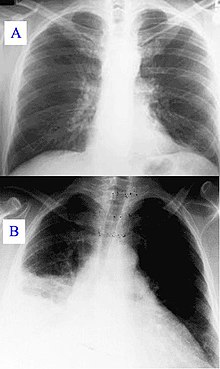| Ventilator-associated pneumonia | |
|---|---|
| Other names | Ventilator-acquired pneumonia |
 | |
| Chest X-Ray of a person infected by pneumonia | |
| Specialty | Critical Care Medicine
Pulmonology Paediatric Critical Care Medicine Infectious Diseases |
| Causes | Mechanical ventilation, Microaspiration past endotracheal tube cuff, prior use of broad-spectrum antimicrobials |
Ventilator-associated pneumonia (VAP) is a type of lung infection that occurs in people who are on mechanical ventilation breathing machines in hospitals. As such, VAP typically affects critically ill persons that are in an intensive care unit (ICU) and have been on a mechanical ventilator for at least 48 hours.[1][2] VAP is a major source of increased illness and death. Persons with VAP have increased lengths of ICU hospitalization and have up to a 20–30% death rate.[3] The diagnosis of VAP varies among hospitals and providers but usually requires a new infiltrate on chest x-ray plus two or more other factors. These factors include temperatures of >38 °C or <36 °C, a white blood cell count of >12 × 109/ml, purulent secretions from the airways in the lung, and/or reduction in gas exchange.[2][4]
A different less studied infection found in mechanically ventilated people is ventilator-associated tracheobronchitis (VAT).[5] As with VAP, tracheobronchial infection can colonise the trachea and travel to the bronchi. VAT may be a risk factor for VAP.[5]
- ^ Cooper, Adam S. (2021). "Oral Hygiene Care to Prevent Ventilator-Associated Pneumonia in Critically Ill Patients". Critical Care Nurse. 41 (4): 80–82. doi:10.4037/ccn2021314. PMID 34333609. S2CID 236773722.
- ^ a b Michetti CP, Fakhry SM, Ferguson PL, Cook A, Moore FO, Gross R (May 2012). "Ventilator-associated pneumonia rates at major trauma centers compared with a national benchmark: a multi-institutional study of the AAST". The Journal of Trauma and Acute Care Surgery. 72 (5): 1165–73. doi:10.1097/TA.0b013e31824d10fa. PMID 22673241. S2CID 19476292.
- ^ Cook D (2000). "Ventilator associated pneumonia: perspectives on the burden of illness". Intensive Care Medicine. 26 (Suppl 1): S31-7. doi:10.1007/s001340051116. PMID 10786956. S2CID 22849696.
- ^ Koenig SM, Truwit JD (October 2006). "Ventilator-associated pneumonia: diagnosis, treatment, and prevention". Clinical Microbiology Reviews. 19 (4): 637–57. doi:10.1128/cmr.00051-05. PMC 1592694. PMID 17041138.
- ^ a b Craven DE, Chroneou A, Zias N, Hjalmarson KI (February 2009). "Ventilator-associated tracheobronchitis: the impact of targeted antibiotic therapy on patient outcomes". Chest. 135 (2): 521–528. doi:10.1378/chest.08-1617. PMID 18812452.